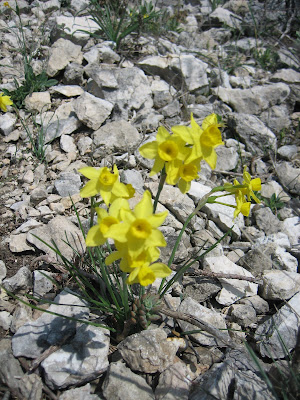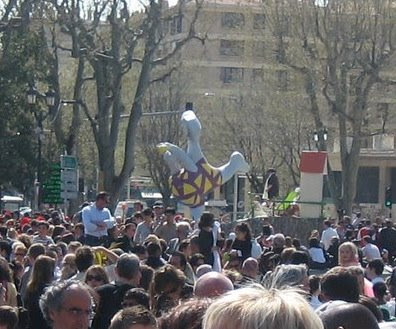In late February in the Calanques the bees were crazy for these globulaire (note the bee in the photo!) as well as all the wild rosemary. This plant grows throughout the Mediterranean region and is one of the flowers that grows in la garrigue, or scrubland. (Actually, you may recall from an earlier post that maquis is another word for scrubland, in particular that found in Corsica. As it turns out, garrigue is used for scrubland that grows on limestone and that maquis grows on siliceous earth.)

This one is a kind of euphorbe:

That last photo was also taken in February. Here's what euphorbe looks like as of mid-April:

In mid-March, (wild) iris nain, or "dwarf iris", started popping up all over the place. As you can see, they're really low to the ground (almost like a crocus). Around here, the "yellow" ones seem to vary from white to pale yellow and the purple ones tend to be paler than garden irises. These photos were taken on a hike between Lac Bimont and Victoire:


On that same hike between Bimont and Victoire, we also saw this flower that our friends said is a romantic wild orchid. No, "romantic" isn't really part of its name, but the photo sure looks romantic (or cheesy) doesn't it? I did that gauzy soft focus so you could better see the flower against the "noisy" background.

The first weekend of April near Saint Cannat, we saw budding oak trees. Who knew their leaves started off pink and fuzzy? Actually, James did, but I had never seen such a thing.

This flower is called ciste. The petals look really dry and papery; however, they feel soft like normal flower petals.

Ciste is all over the place in this region. We'd seen its furry sage colored leaves on every hike but this was the first ciste flower we had seen this season. It was only hours after we saw this flower that we read in our hiking book that it's legerement parfumée, or "delicately scented". Lucky for us, it's now high season in the Calanques for ciste and they do smell really good. They smell "green" like the way a green banana smells green but sweet and light like a flower (and not at all like bananas).

These are called dame d'onze-heures, or "the lady of 11 o'clock". They're in the hyacinth family, and toxic!

We also saw this one, which is a wild pea called gessette:

There are lots of wild daffodils up on Victoire now. These are narcisse d'asso. They're really tiny (not more than 6in high and maybe half a centimeter across the diameter of the trumpet). This picture isn't great because it was windy.

And there were these too:

Any guesses about what those might be?
Last weekend on our hike from Marseille to Cassis we saw more of the pink ciste, and these, another type of ciste, "sage-leafed ciste":

Wild honeysuckle in close-up:

And not so close-up:

This one, the urosperme de daléchamps, is named after the French doctor and naturalist Jacques Daléchamps, who lived in the 16th century.

Right next to the urosperme was this fuzzy, spiky little thing that I have not been able to identify:

And, finally, coronille, of which there are many varieties:


















